Graphene with Ni-Grid as Semitransparent Electrode for Bulk Heterojunction Solar Cells (BHJ-SCs)
Abstract
:1. Introduction
2. Materials and Methods
2.1. Preparation and Characterization of GRAPHENE on Ni-Grid as Electrode
2.2. Realization of the Solar Cells
3. Results and Discussion
4. Conclusions
Supplementary Materials
Author Contributions
Funding
Institutional Review Board Statement
Informed Consent Statement
Data Availability Statement
Acknowledgments
Conflicts of Interest
References
- Brabec, C.J.; Distler, A.; Du, X.; Egelhaaf, H.-J.; Hauch, J.; Heumueller, T.; Li, N. Material Strategies to Accelerate OPV Technology Toward a GW Technology. Adv. Energy Mater. 2020, 10, 2001864. [Google Scholar] [CrossRef]
- Available online: https://www.nrel.gov/pv/cell-efficiency.html (accessed on 19 February 2022).
- Lin, Y.; Adilbekova, B.; Firdaus, Y.; Yengel, E.; Faber, H.; Sajjad, M.; Zheng, X.; Yarali, E.; Seitkhan, A.; Bakr, O.M.; et al. 17% Efficient Organic Solar Cells Based on Liquid Exfoliated WS2 as a Replacement for PEDOT:PSS. Adv. Mater. 2019, 31, 1902965. [Google Scholar] [CrossRef] [PubMed]
- Zhu, C.; Yuan, J.; Cai, F.; Meng, L.; Zhang, H.; Chen, H.; Li, J.; Qiu, B.; Peng, H.; Chen, S.; et al. Tuning the electron-deficient core of a non-fullerene acceptor to achieve over 17% efficiency in a single-junction organic solar cell. Energy Environ. Sci. 2020, 13, 2459–2466. [Google Scholar] [CrossRef]
- Ma, Q.; Jia, Z.; Meng, L.; Zhang, J.; Zhang, H.; Huang, W.; Yuan, J.; Gao, F.; Wan, Y.; Zhang, Z.; et al. Promoting charge separation resulting in ternary organic solar cells efficiency over 17.5%. Nano Energy 2020, 78, 105272. [Google Scholar] [CrossRef]
- Lu, S.; Sun, Y.; Ren, K.; Liu, K.; Wang, Z.; Qu, S. Recent Development in ITO-free Flexible Polymer Solar Cells. Polymers 2018, 10, 5. [Google Scholar] [CrossRef] [Green Version]
- Huang, J.; Ren, Z.; Zhang, Y.; Liu, K.; Zhang, H.; Tang, H.; Yan, C.; Zheng, Z.; Li, G. Stretchable ITO-Free Organic Solar Cells with Intrinsic Anti-Reflection Substrate for High-Efficiency Outdoor and Indoor Energy Harvesting. Adv. Funct. Mater. 2021, 31, 2010172. [Google Scholar] [CrossRef]
- Shaygan, M.; Otto, M.; Sagade, A.A.; Chavarin, C.A.; Bacher, G.; Mertin, W.; Neumaier, D. Low Resistive Edge Contacts to CVD-Grown Graphene Using a CMOS Compatible Metal. Ann. Der Phys. 2017, 529, 1600410. [Google Scholar] [CrossRef] [Green Version]
- Jang, H.; Kim, M.S.; Jang, W.; Son, H.; Wang, D.H.; Kim, F.S. Highly conductive PEDOT: PSS electrode obtained via post-treatment with alcoholic solvent for ITO-free organic solar cells. J. Ind. Eng. Chem. 2020, 86, 205. [Google Scholar] [CrossRef]
- Lucarelli, G.; Brown, T.M. Development of Highly Bendable Transparent Window Electrodes Based on MoOx, SnO2, and Au Dielectric/Metal/Dielectric Stacks: Application to Indium Tin Oxide (ITO)-Free Perovskite Solar Cells. Front. Mater. 2019, 6, 310. [Google Scholar] [CrossRef]
- Mundinamani, S. Large Area, Multilayer Graphene Films as a Flexible Electronic Material. ACS Omega 2020, 5, 17479. [Google Scholar] [CrossRef]
- La Notte, L.; Villari, E.; Palma, A.L.; Sacchetti, A.; Michela Giangregorio, M.; Bruno, G.; Di Carlo, A.; Bianco, G.V.; Reale, A. Laser-patterned functionalized CVD-graphene as highly transparent conductive electrodes for polymer solar cells. Nanoscale 2017, 9, 62–69. [Google Scholar] [CrossRef] [PubMed]
- Fang, B.; Chang, D.; Xu, Z.; Gao, C. A review on graphene fibers: Expectations, advances, and prospects. Adv. Mater. 2020, 32, 1902664. [Google Scholar] [CrossRef] [PubMed]
- Rosli, N.N.; Ibrahim, M.A.; Ludin, N.A.; Teridi, M.A.; Sopian, K. A review of graphene based transparent conducting films for use in solar photovoltaic applications. Renew. Sustain. Energy Rev. 2019, 99, 83. [Google Scholar] [CrossRef]
- Lee, H.C.; Liu, W.-W.; Chai, S.-P.; Mohamed, A.R.; Aziz, A.; Khe, C.-S. Review of the synthesis, transfer, characterization and growth mechanisms of single and multilayer graphene. RSC Adv. 2017, 7, 15644–15693. [Google Scholar] [CrossRef]
- Kairi, M.I.; Dayou, S.; Kairi, N.I.; Bakar, S.A.; Vigolo, B.; Mohamed, A.R. Toward high production of graphene flakes—A review on recent developments in their synthesis methods and scalability. J. Mater. Chem. A 2018, 6, 15010–15026. [Google Scholar] [CrossRef] [Green Version]
- Saeed, M.; Alshammari, Y.; Majeed, S.A.; Al-Nasrallah, E. Chemical Vapour Deposition of Graphene—Synthesis, Characterisation, and Applications: A Review. Molecules 2020, 25, 3856. [Google Scholar] [CrossRef] [PubMed]
- Bubnova, O. A decade of R2R graphene manufacturing. Nat. Nanotechnol. 2021, 16, 1050. [Google Scholar] [CrossRef]
- You, R.; Liu, Y.-Q.; Hao, Y.-L.; Han, D.-D.; Zhang, Y.-L.; You, Z. Laser Fabrication of Graphene-Based Flexible Electronics. Adv. Mater. 2020, 32, 1901981. [Google Scholar] [CrossRef]
- Cao, M.; Xiong, D.B.; Yang, L.; Li, S.; Xie, Y.; Guo, Q.; Li, Z.; Adams, H.; Gu, J.; Fan, T.; et al. Ultrahigh electrical conductivity of graphene embedded in metals. Adv. Funct. Mater. 2019, 29, 1806792. [Google Scholar] [CrossRef]
- Hamidouche, L.; Montanaro, A.; Rosticher, M.; Grimaldi, E.; Poupet, B.; Taniguchi, T.; Watanabe, K.; Plaçais, B.; Baudin, E.; Legagneux, P. Optoelectronic mixing in high-mobility graphene. ACS Photonics 2020, 8, 369. [Google Scholar] [CrossRef]
- Tomašević-Ilić, T.; Jovanović, Đ.; Popov, I.; Fandan, R.; Pedrós, J.; Spasenović, M.; Gajić, R. Reducing sheet resistance of self-assembled transparent graphene films by defect patching and doping with UV/ozone treatment. Appl. Surf. Sci. 2018, 458, 446–453. [Google Scholar] [CrossRef] [Green Version]
- Bianco, G.V.; Sacchetti, A.; Milella, A.; Grande, M.; D’Orazio, A.; Capezzuto, P.; Bruno, G. Extraordinary low sheet resistance of CVD graphene by thionyl chloride chemical doping. Carbon 2020, 170, 75–84. [Google Scholar] [CrossRef]
- Mallikarjuna, K.; Kim, H. Highly transparent conductive reduced graphene oxide/silver nanowires/silver grid electrodes for low-voltage electrochromic smart windows. ACS Appl. Mater. Interfaces 2018, 11, 1969. [Google Scholar] [CrossRef] [PubMed]
- Ricciardulli, A.G.; Yang, S.; Wetzelaer, G.-J.A.H.; Feng, X.; Blom, P.W.M. Hybrid Silver Nanowire and Graphene-Based Solution-Processed Transparent Electrode for Organic Optoelectronics. Adv. Funct. Mater. 2018, 28, 1706010. [Google Scholar] [CrossRef]
- Wu, J.; Becerril, H.A.; Bao, Z.; Liu, Z.; Chen, Y.; Peumans, P. Organic solar cells with solution-processed graphene transparent electrodes. Appl. Phys. Lett. 2008, 92, 263302. [Google Scholar] [CrossRef] [Green Version]
- Wang, Y.; Tong, S.W.; Xu, X.F.; Özyilmaz, B.; Loh, K.P. Interface Engineering of Layer-by-Layer Stacked Graphene Anodes for High-Performance Organic Solar Cells. Adv. Mater. 2011, 23, 1514–1518. [Google Scholar] [CrossRef]
- La Notte, L.; Cataldi, P.; Ceseracciu, L.; Bayer, I.S.; Athanassiou, A.; Marras, S.; Villari, E.; Brunetti, F.; Reale, A. Fully-sprayed flexible polymer solar cells with a cellulose-graphene electrode. Mater. Today Energy 2018, 7, 105–112. [Google Scholar] [CrossRef]
- La Notte, L.; Bianco, G.V.; Palma, A.L.; Di Carlo, A.; Bruno, G.; Reale, A. Sprayed organic photovoltaic cells and mini-modules based on chemical vapor deposited graphene as transparent conductive electrode. Carbon 2018, 129, 878–883. [Google Scholar] [CrossRef]
- Ye, N.; Liang, T.; Zhan, L.; Kong, Y.; Xie, S.; Ma, X.; Chen, H.; Su, H.; Xu, M. High-performance bendable organic solar cells with silver nanowire-graphene hybrid electrode. IEEE J. Photovolt. 2018, 9, 214. [Google Scholar] [CrossRef]
- Ye, N.; Yan, J.; Xie, S.; Kong, Y.; Liang, T.; Chen, H.; Xu, M. Silver nanowire–graphene hybrid transparent conductive electrodes for highly efficient inverted organic solar cells. Nanotechnology 2017, 28, 305402. [Google Scholar] [CrossRef]
- Shin, D.H.; Jang, C.W.; Lee, H.S.; Seo, S.W.; Choi, S.-H. Semitransparent Flexible Organic Solar Cells Employing Doped-Graphene Layers as Anode and Cathode Electrodes. ACS Appl. Mater. Interfaces 2018, 10, 3596–3601. [Google Scholar] [CrossRef] [PubMed]
- Koo, D.; Jung, S.; Seo, J.; Jeong, G.; Choi, Y.; Lee, J.; Oh, J.; Yang, C.; Park, H. Flexible Organic Solar Cells Over 15% Efficiency with Polyimide-Integrated Graphene Electrodes. Joule 2020, 4, 1021–1034. [Google Scholar] [CrossRef]
- Silambarasan, K.; Archana, J.; Athithya, S.; Harish, S.; Sankar Ganesh, R.; Navaneethan, M.; Ponnusamya, S.; Muthamizhchelvana, C.; Haracd, K.; Hayakawad, Y. Hierarchical NiO@NiS@graphene nanocomposite as a sustainable counter electrode for Pt free dye-sensitized solar cell. Appl. Surf. Sci. 2020, 501, 144010. [Google Scholar] [CrossRef]
- Kim, D.J.; Truong, Q.-; Kim, J.-I.; Suh, Y.; Moon, J.; Lee, S.-E.; Hong, B.H.; Woo, Y.S. Ultrahigh-strength multi-layer graphene-coated Ni film with interface-induced hardening. Carbon 2021, 178, 497–505. [Google Scholar] [CrossRef]
- Woo, Y.S. Transparent Conductive Electrodes Based on Graphene-Related Materials. Micromachines 2019, 10, 13. [Google Scholar] [CrossRef] [Green Version]
- Lancellotti, L.; Bobeico, E.; della Noce, M.; Lucia, V. Mercaldo, Iurie Usatii, Paola Delli Veneri, Giuseppe Valerio Bianco, Alberto Sacchetti, Giovanni Bruno, Graphene as non conventional transparent conductive electrode in silicon heterojunction solar cells. Appl. Surf. Sci. 2020, 525, 146443. [Google Scholar] [CrossRef]
- Juntunen, T.; Jussila, H.; Ruoho, M.; Liu, S.; Hu, G.; Albrow-Owen, T.; Ng, L.W.; Howe, R.C.; Hasan, T.; Sun, Z.; et al. Inkjet printed large-area flexible few-layer graphene thermoelectrics. Adv. Funct. Mater. 2018, 28, 1800480. [Google Scholar] [CrossRef] [Green Version]
- Susanna, G.; Salamandra, L.; Ciceroni, C.; Mura, F.; Brown, T.M.; Reale, A.; Rossi, M.; di Carlo, A.; Brunetti, F. 8.7% Power conversion efficiency polymer solar cell realized with non-chlorinated solvents. Sol. Energy Mater. Sol. Cells 2015, 134, 194–198. [Google Scholar] [CrossRef]
- Gupta, S.K.; Yadav, J.; Chaturvedi, N.; Ranjan, R.; Pali, L.S.; Nalwa, K.S.; Garg, A. Role of DIO vis-à-vis microstructural kinetics during thermal annealing on the performance of PTB7: PC71BM organic solar cells. Sol. Energy 2021, 213, 27. [Google Scholar] [CrossRef]
- Dianetti, M.; di Giacomo, F.; Polino, G.; Ciceroni, C.; Liscio, A.; D’Epifanio, A.; Licoccia, S.; Brown, T.M.; di Carlo, A.; Brunetti, F. TCO-free flexible organo metal trihalide perovskite planar-heterojunction solar cells. Sol. Energy Mater. Sol. Cells 2015, 140, 1. [Google Scholar] [CrossRef]
- Choi, Y.-Y.; Kang, S.J.; Kim, H.-K.; Choi, W.M.; Na, S.-I. Multilayer graphene films as transparent electrodes for organic photovoltaic devices. Sol. Energy Mater. Sol. Cells 2012, 96, 281. [Google Scholar] [CrossRef]
- Christopher, M. Proctor, Thuc-Quyen Nguyen, Effect of leakage current and shunt resistance on the light intensity dependence of organic solar cells. Appl. Phys. Lett. 2015, 106, 083301. [Google Scholar]
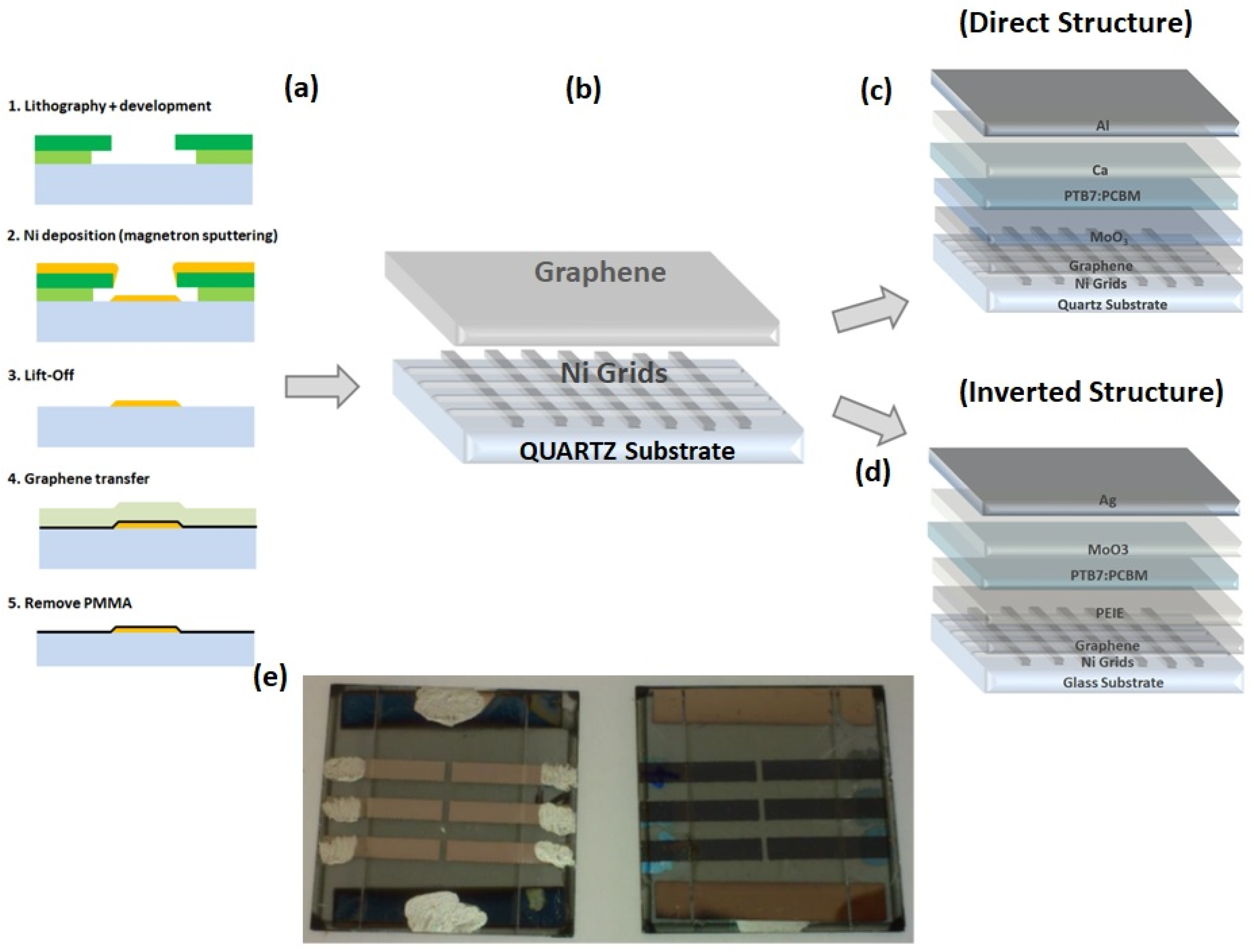


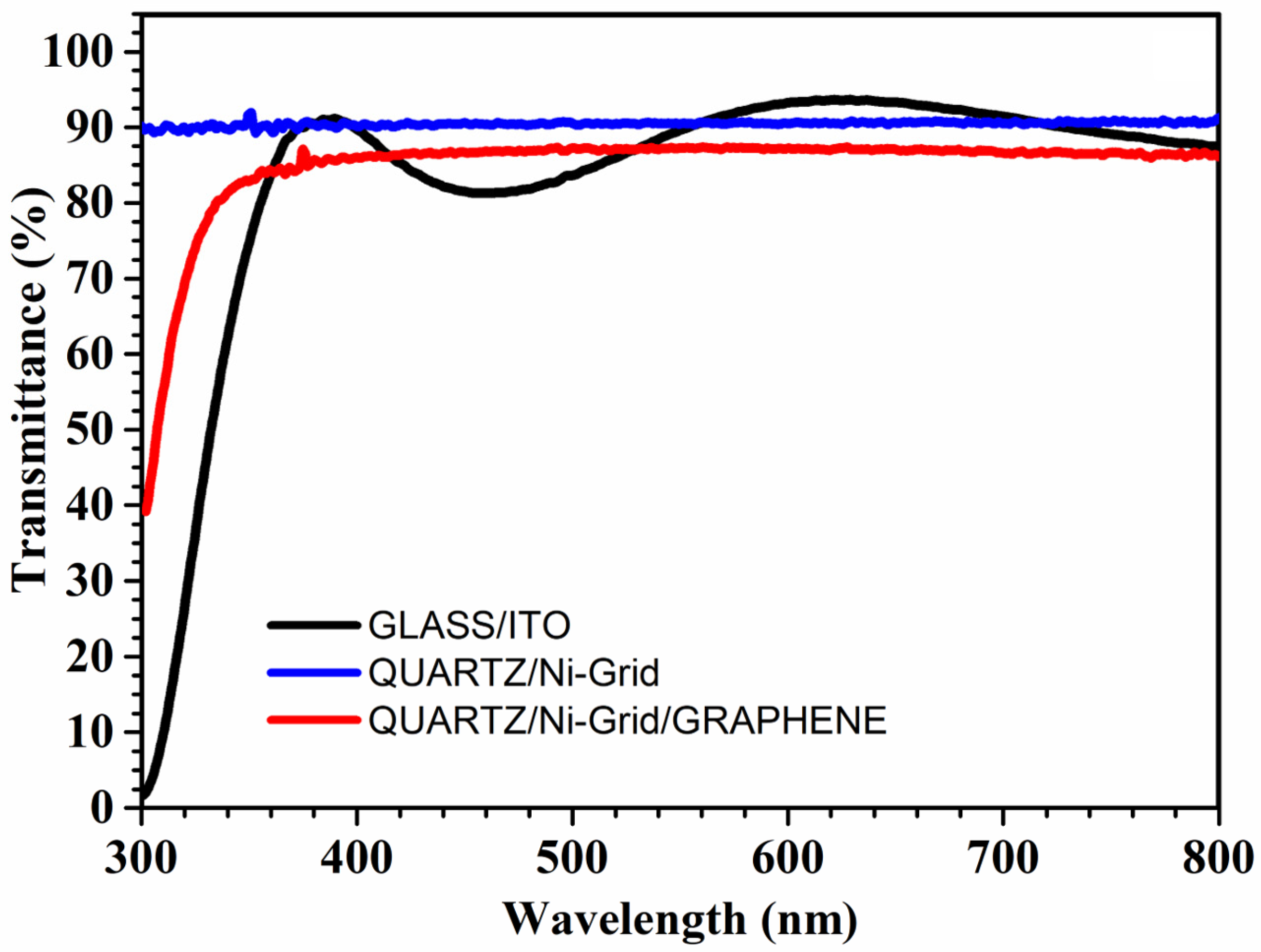
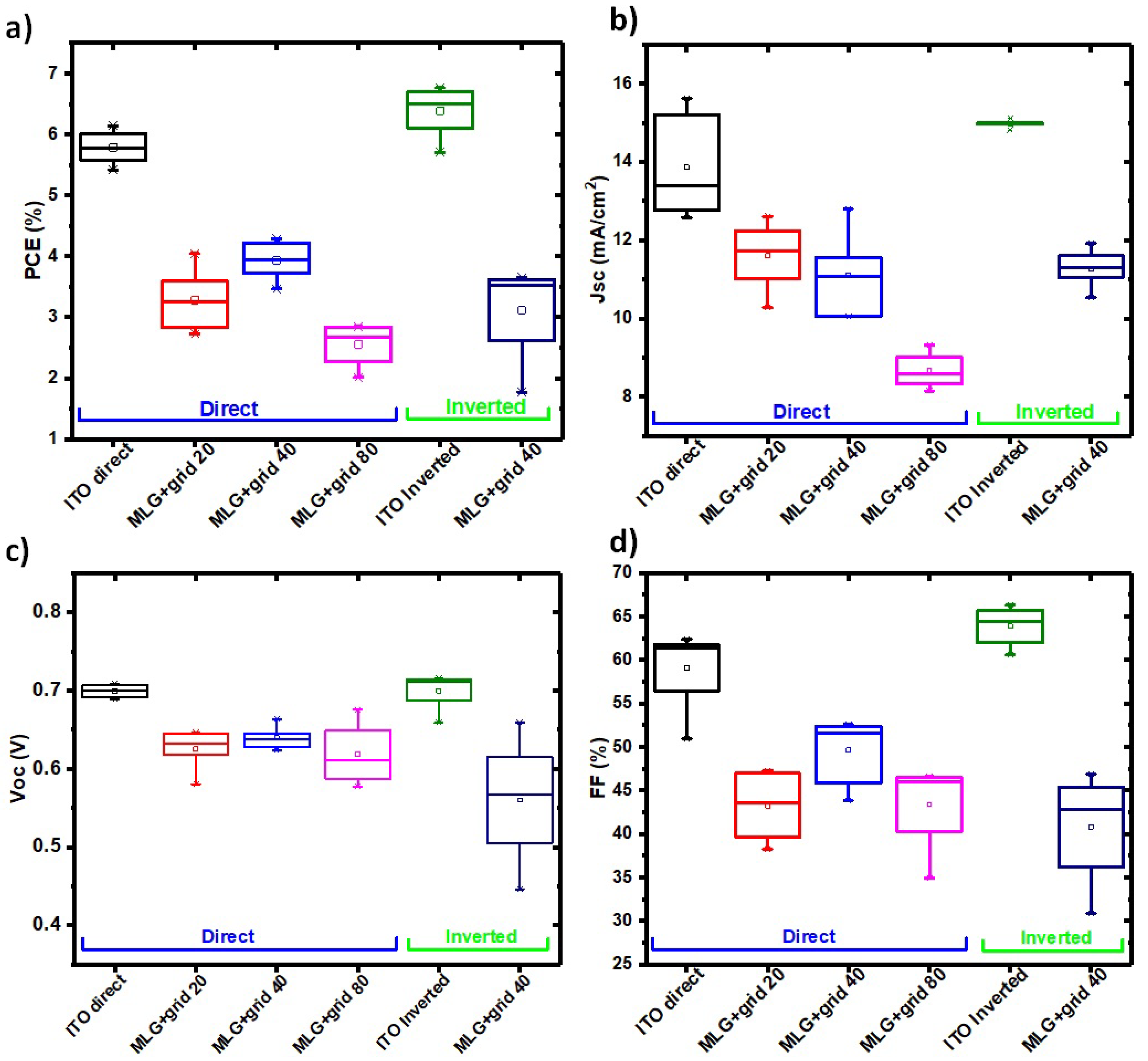
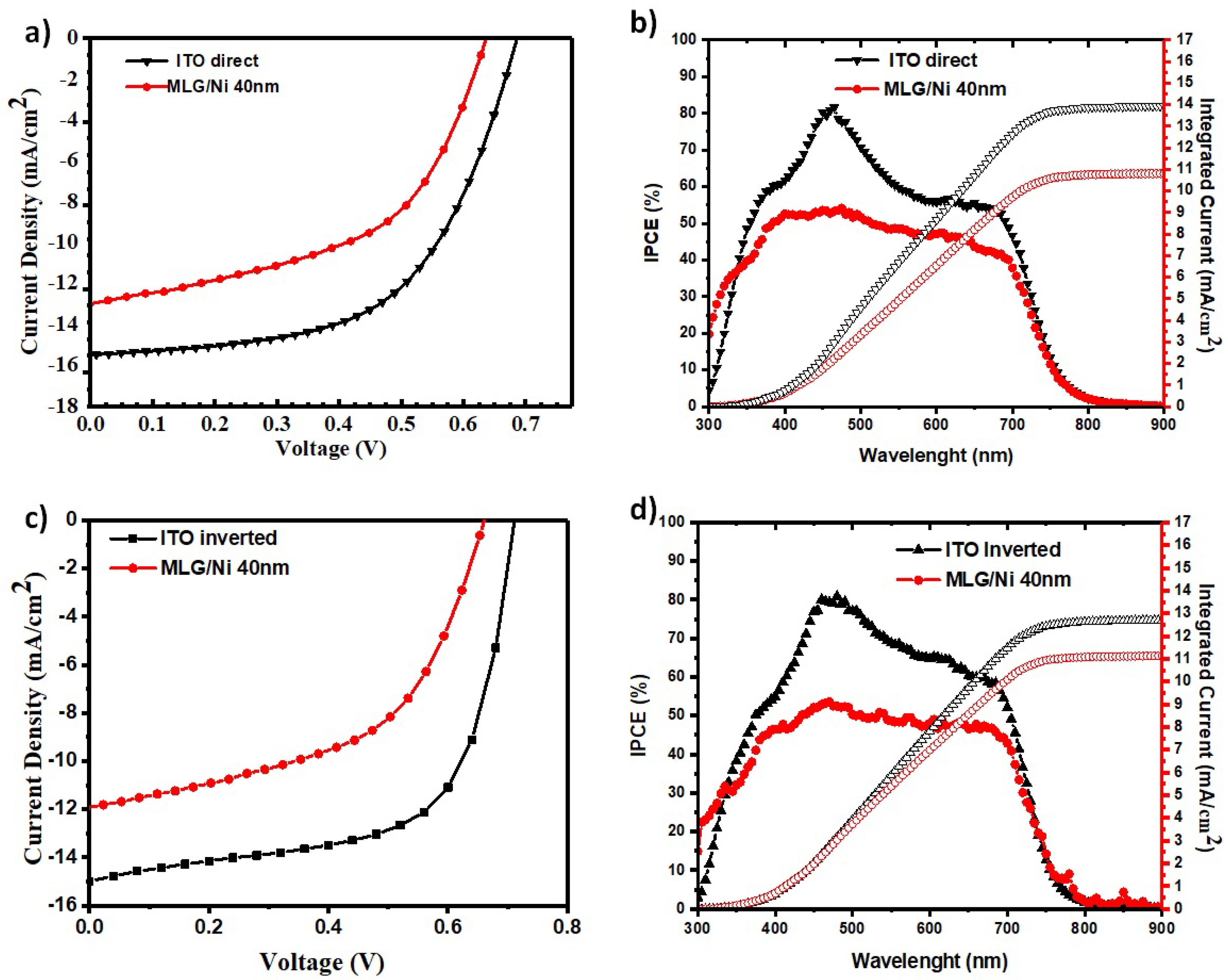
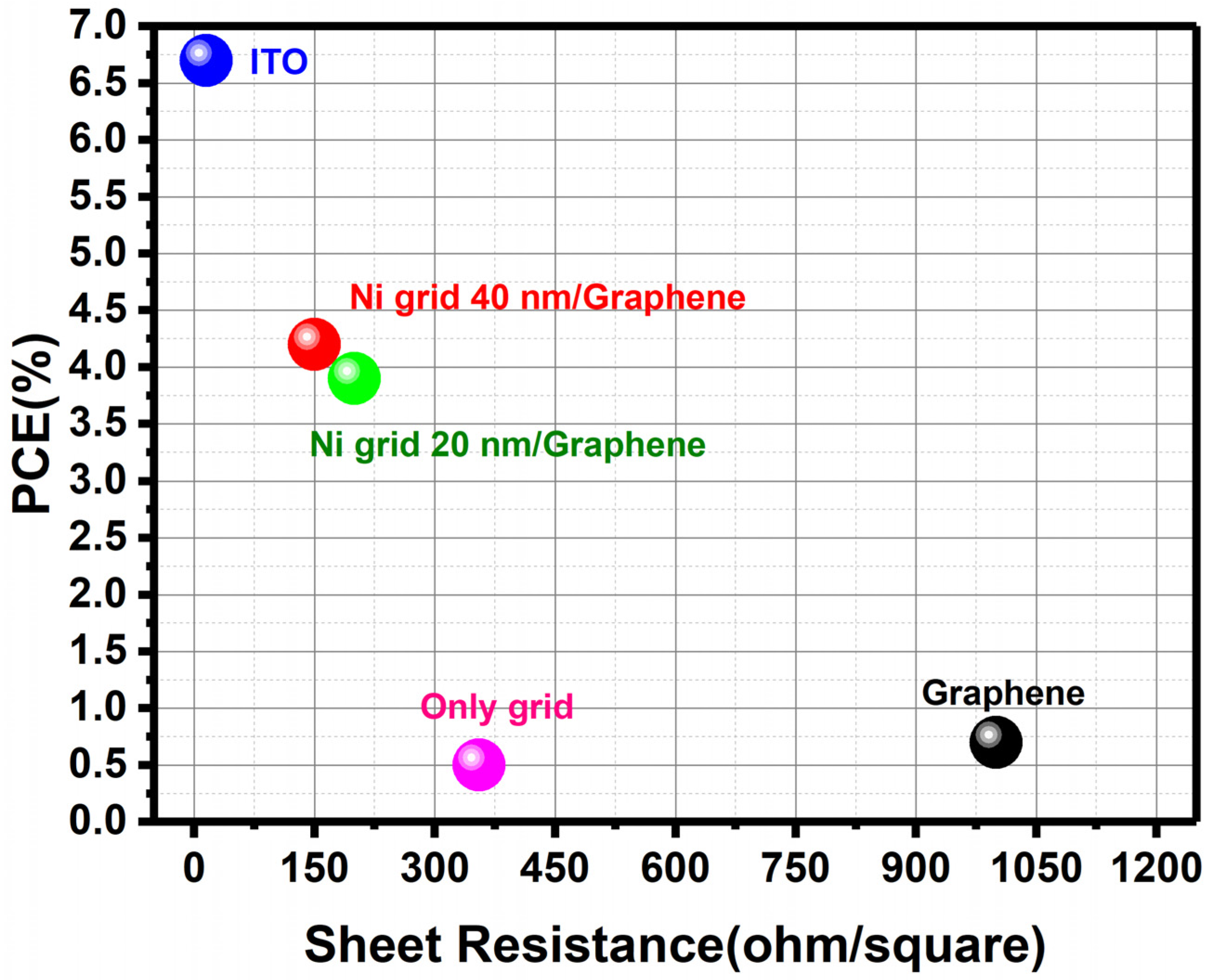
| Anodes | Sheet Resistance (Ω/□) | Voc (mV) | Jsc (mA/cm2) | FF (%) | PCE (%) |
|---|---|---|---|---|---|
| ITO | ~15 | 689 | 15.6 | 57.2 | 6.1 |
| Ni-grid (40 nm) | ~355 | 633 | 2.2 | 40.2 | 0.5 |
| MLG | ~900 | 580 | 4.7 | 26.0 | 0.7 |
| MLG/Ni-grid (20 nm) | ~200 | 646 | 12.6 | 47.3 | 3.9 |
| MLG/Ni-grid (40 nm) | ~150 | 638 | 12.7 | 51.9 | 4.2 |
| MLG/Ni-grid (80 nm) | ~35 | 675 | 9.1 | 45.6 | 2.8 |
| Anodes | Sheet Resistance (Ω/□) | Voc (mV) | Jsc (mA/cm2) | FF (%) | PCE (%) |
|---|---|---|---|---|---|
| ITO | ~15 | 712 | 15,1 | 63.2 | 6.7 |
| Ni-grid (40 nm) | ~355 | 554 | 1.7 | 42.1 | 0.4 |
| MLG | ~900 | 405 | 3.5 | 35.2 | 0.5 |
| MLG/Ni-grid 40 nm | ~150 | 659 | 11.9 | 46.5 | 3.6 |
Publisher’s Note: MDPI stays neutral with regard to jurisdictional claims in published maps and institutional affiliations. |
© 2022 by the authors. Licensee MDPI, Basel, Switzerland. This article is an open access article distributed under the terms and conditions of the Creative Commons Attribution (CC BY) license (https://creativecommons.org/licenses/by/4.0/).
Share and Cite
Dianetti, M.; Susanna, G.; Calabrò, E.; Polino, G.; Otto, M.; Neumaier, D.; Reale, A.; Brunetti, F. Graphene with Ni-Grid as Semitransparent Electrode for Bulk Heterojunction Solar Cells (BHJ-SCs). Polymers 2022, 14, 1046. https://doi.org/10.3390/polym14051046
Dianetti M, Susanna G, Calabrò E, Polino G, Otto M, Neumaier D, Reale A, Brunetti F. Graphene with Ni-Grid as Semitransparent Electrode for Bulk Heterojunction Solar Cells (BHJ-SCs). Polymers. 2022; 14(5):1046. https://doi.org/10.3390/polym14051046
Chicago/Turabian StyleDianetti, Martina, Gianpaolo Susanna, Emanuele Calabrò, Giuseppina Polino, Martin Otto, Daniel Neumaier, Andrea Reale, and Francesca Brunetti. 2022. "Graphene with Ni-Grid as Semitransparent Electrode for Bulk Heterojunction Solar Cells (BHJ-SCs)" Polymers 14, no. 5: 1046. https://doi.org/10.3390/polym14051046
APA StyleDianetti, M., Susanna, G., Calabrò, E., Polino, G., Otto, M., Neumaier, D., Reale, A., & Brunetti, F. (2022). Graphene with Ni-Grid as Semitransparent Electrode for Bulk Heterojunction Solar Cells (BHJ-SCs). Polymers, 14(5), 1046. https://doi.org/10.3390/polym14051046








